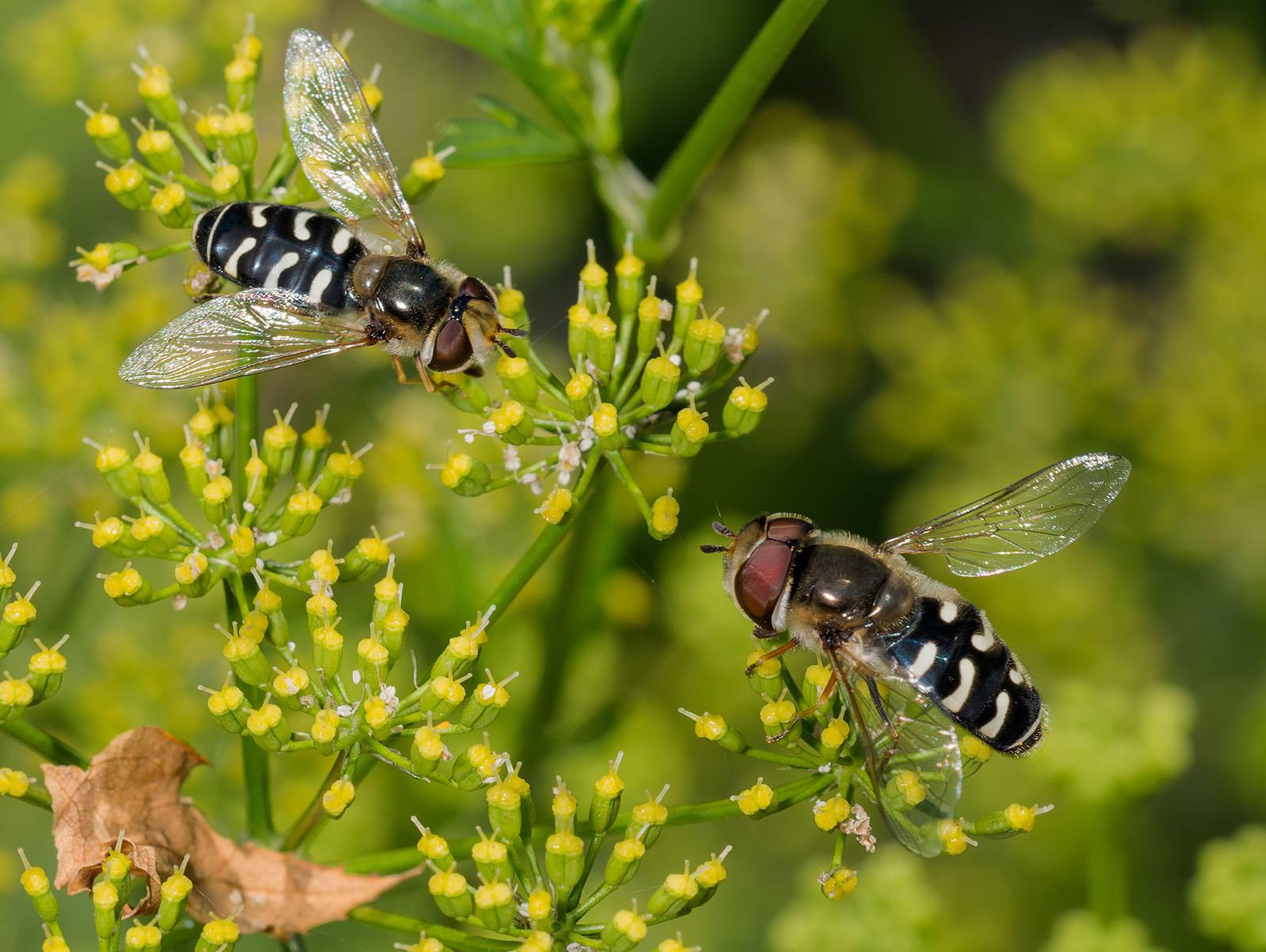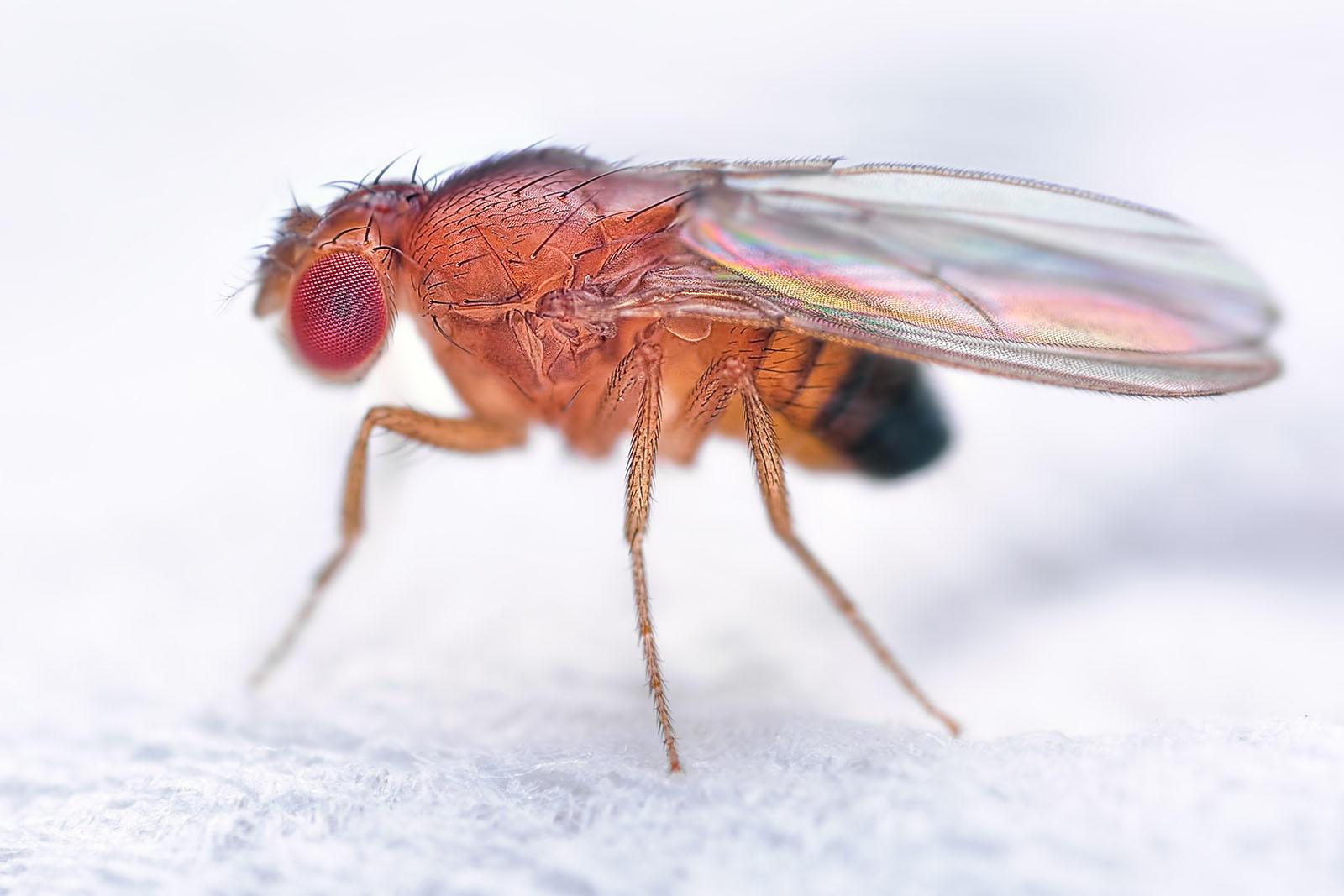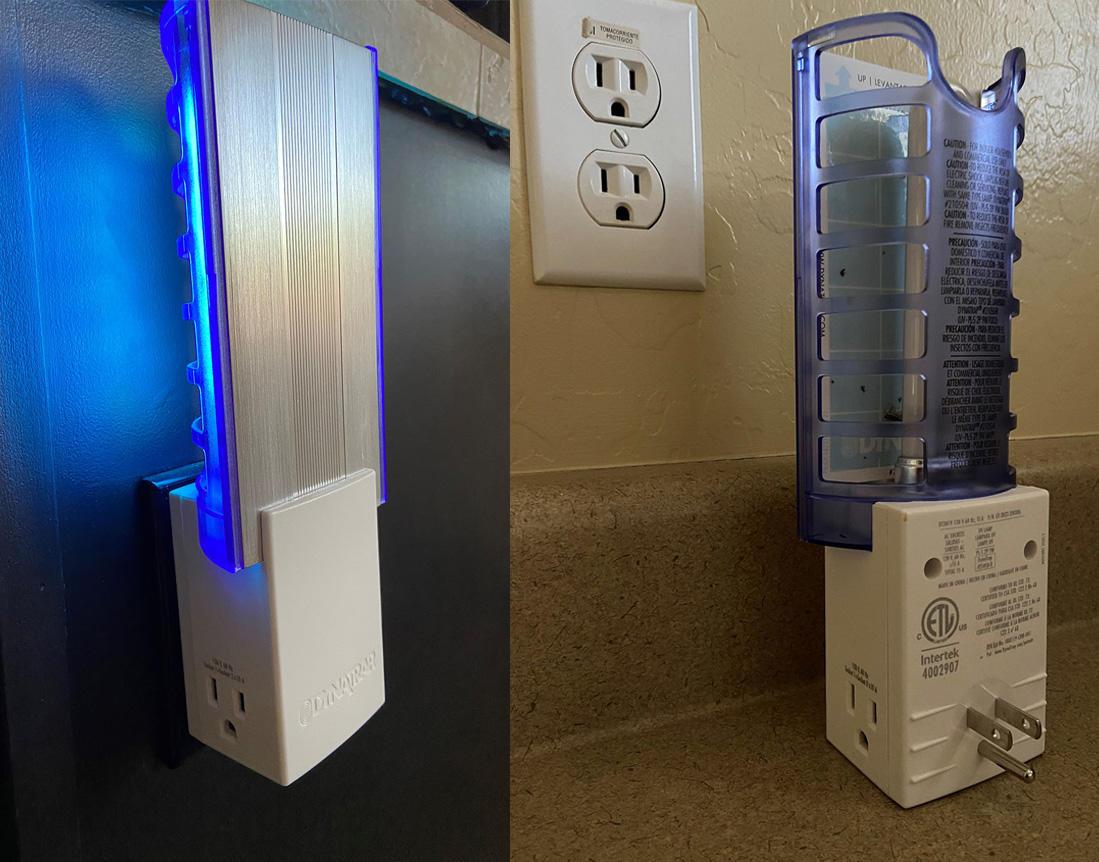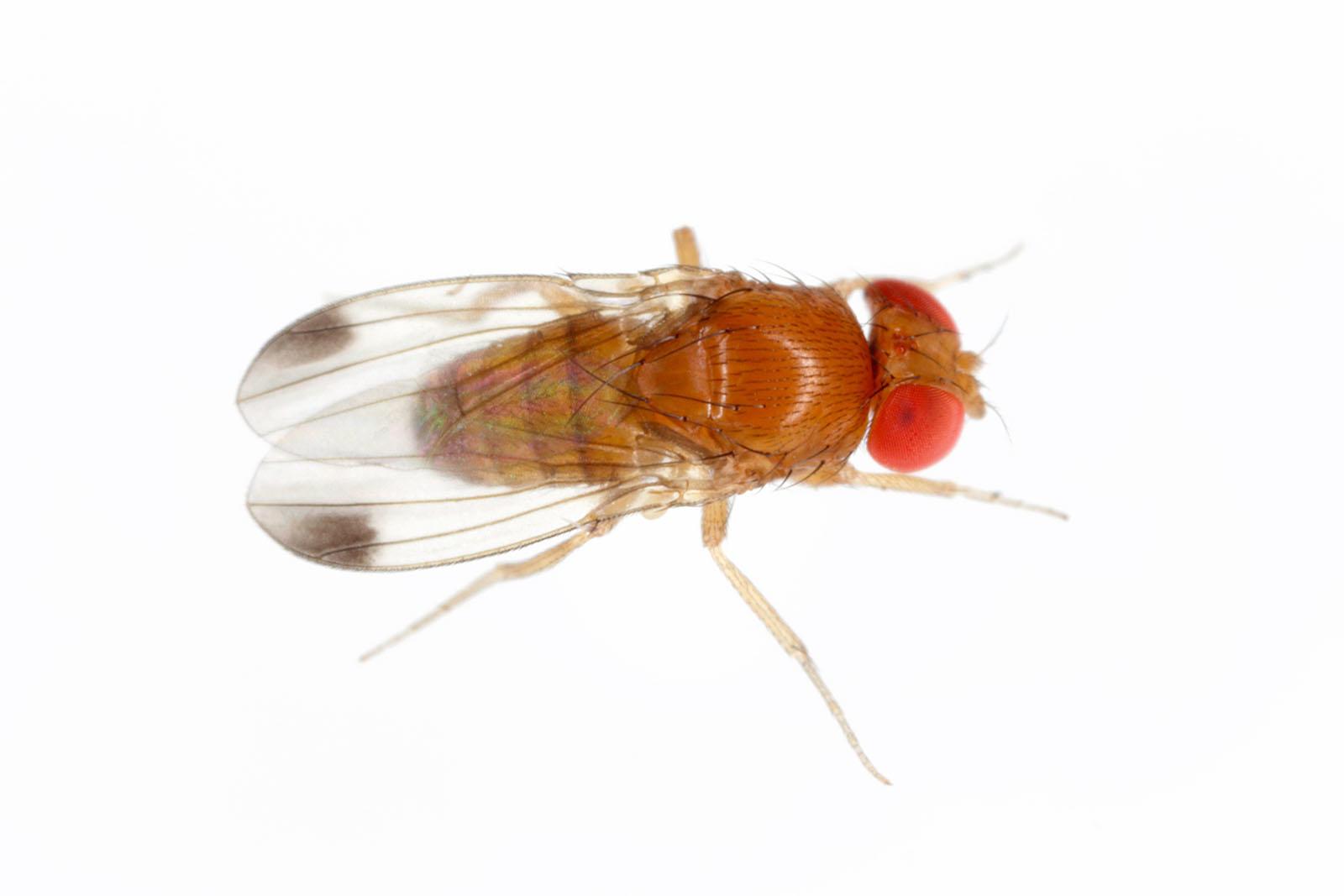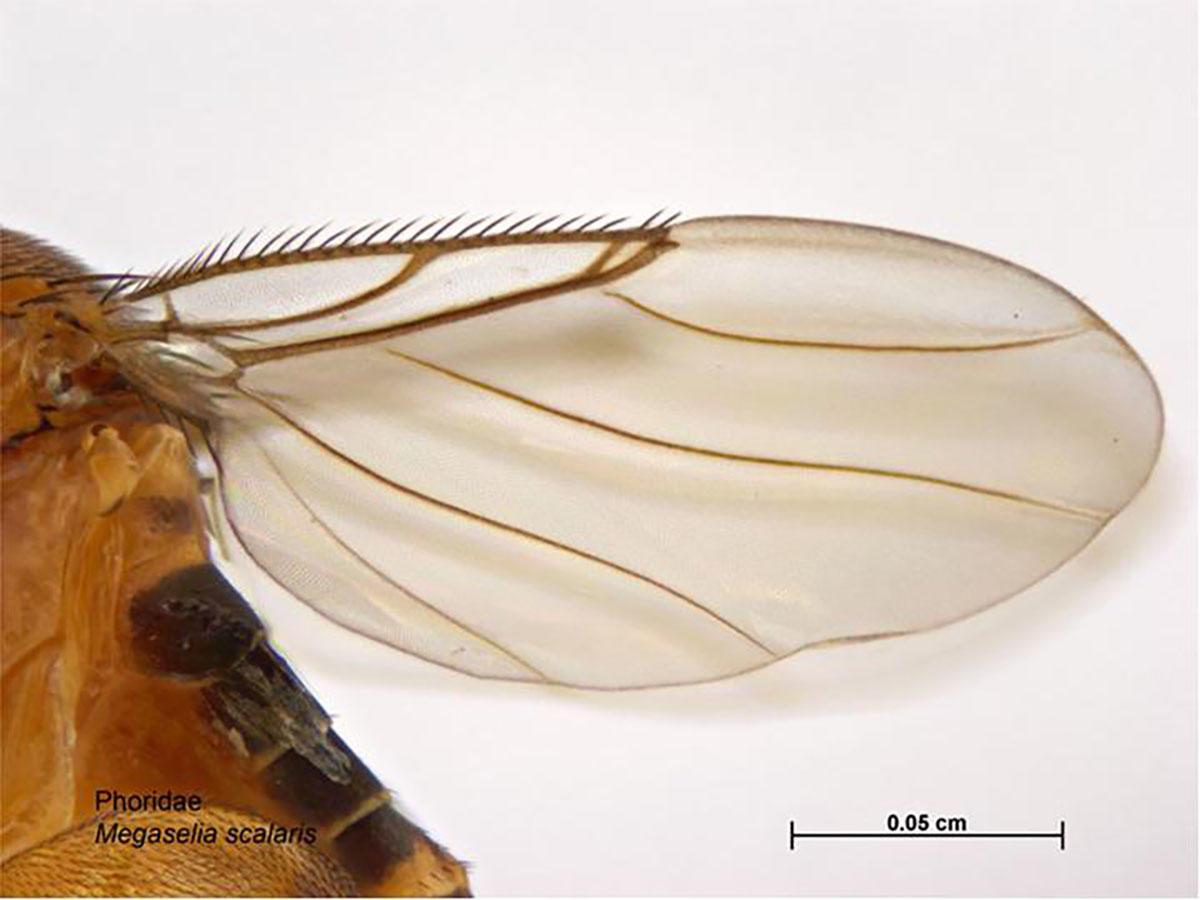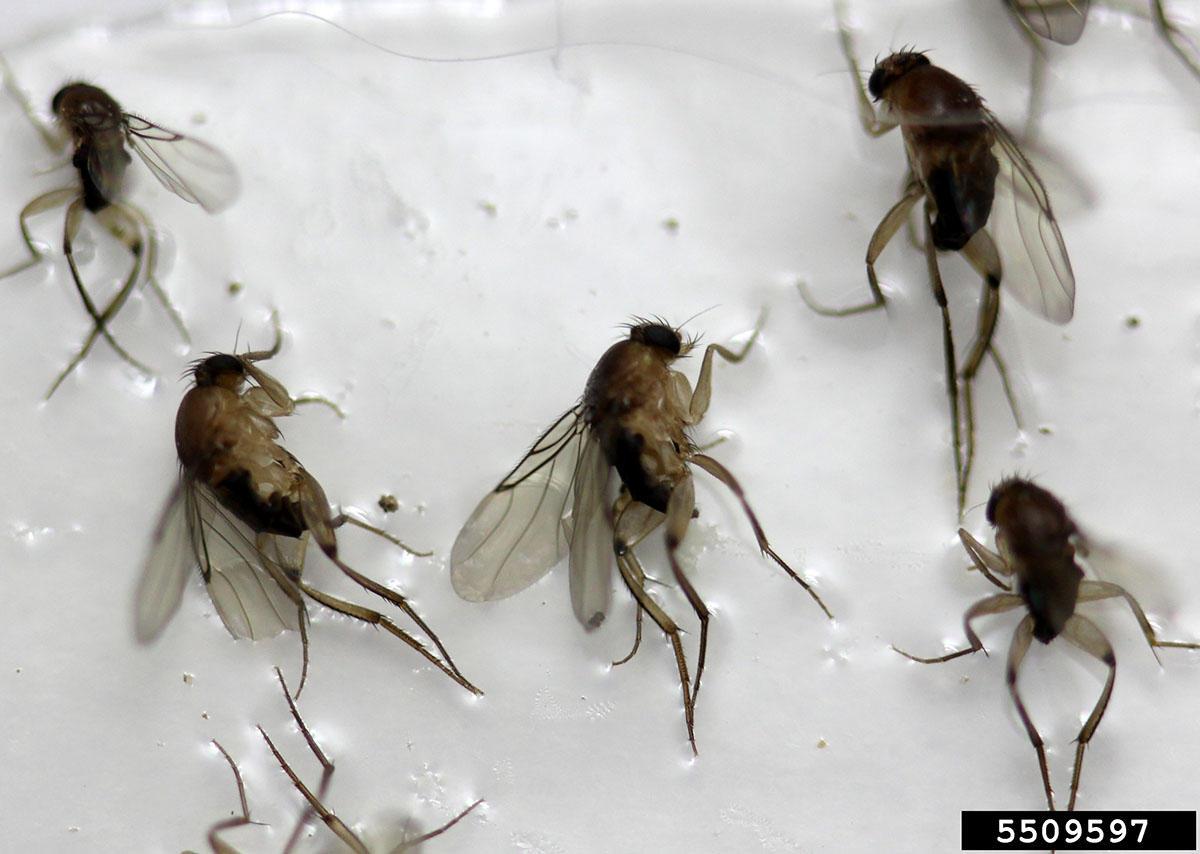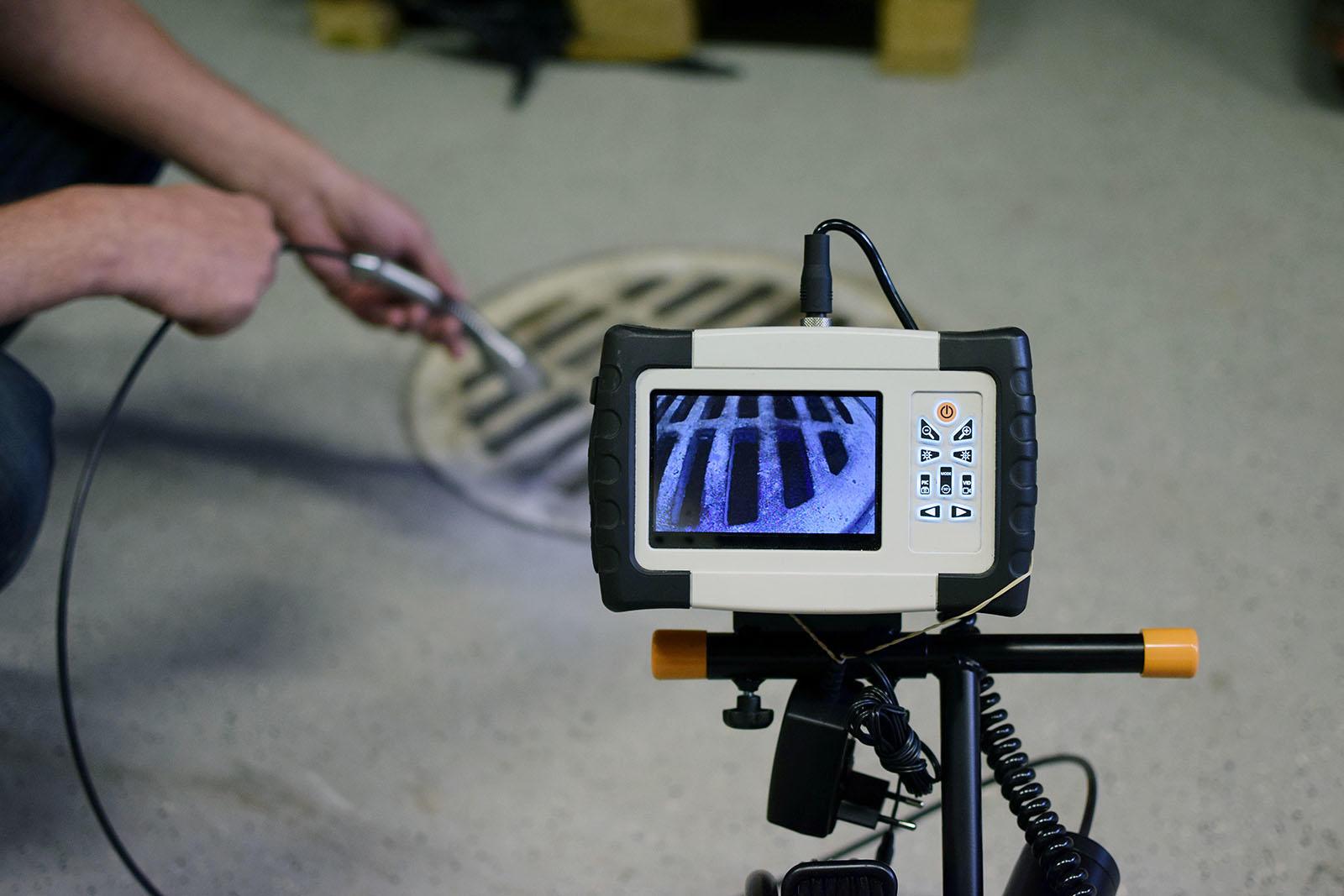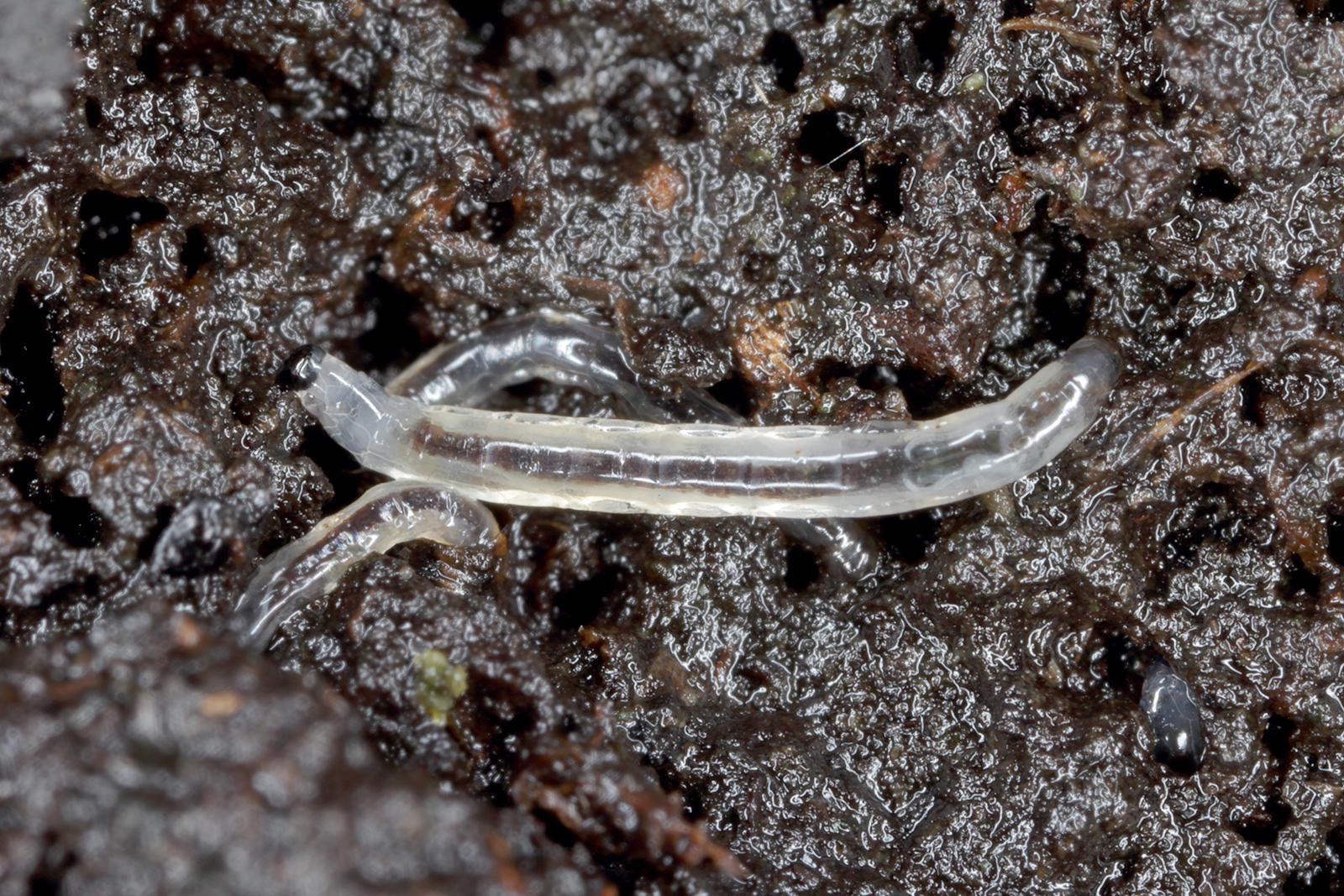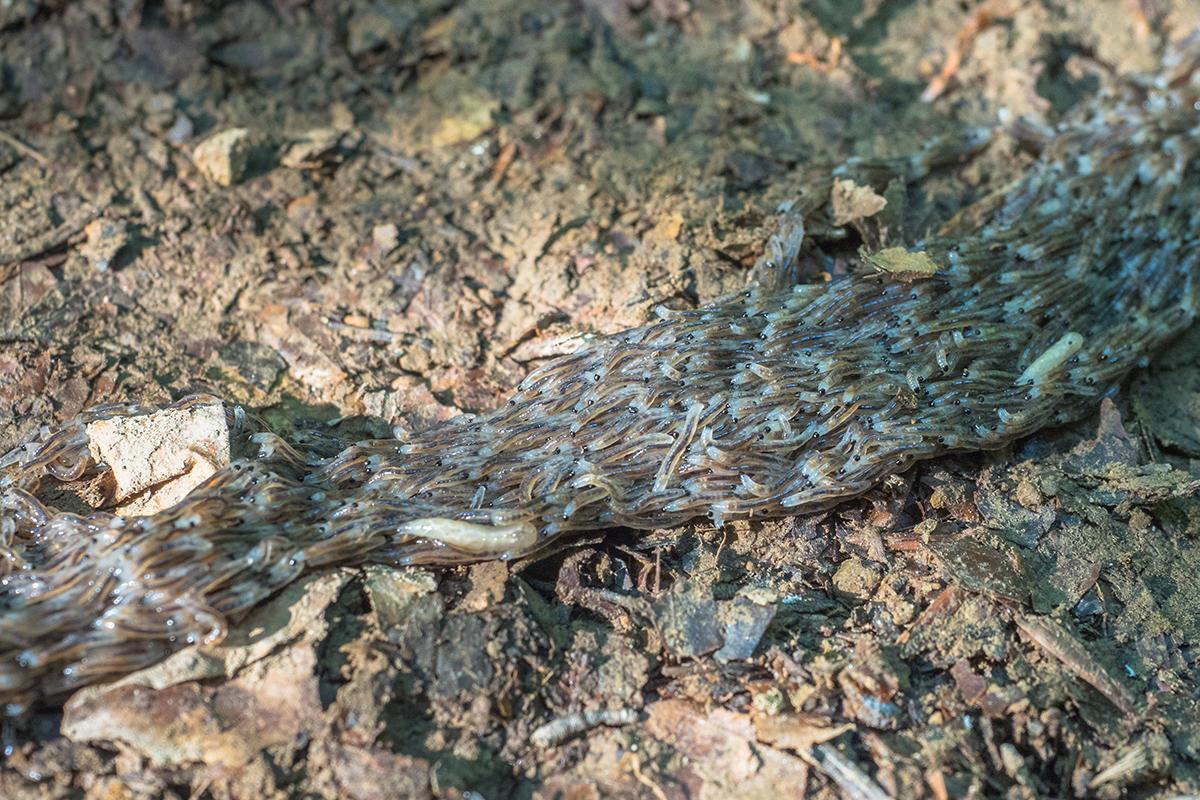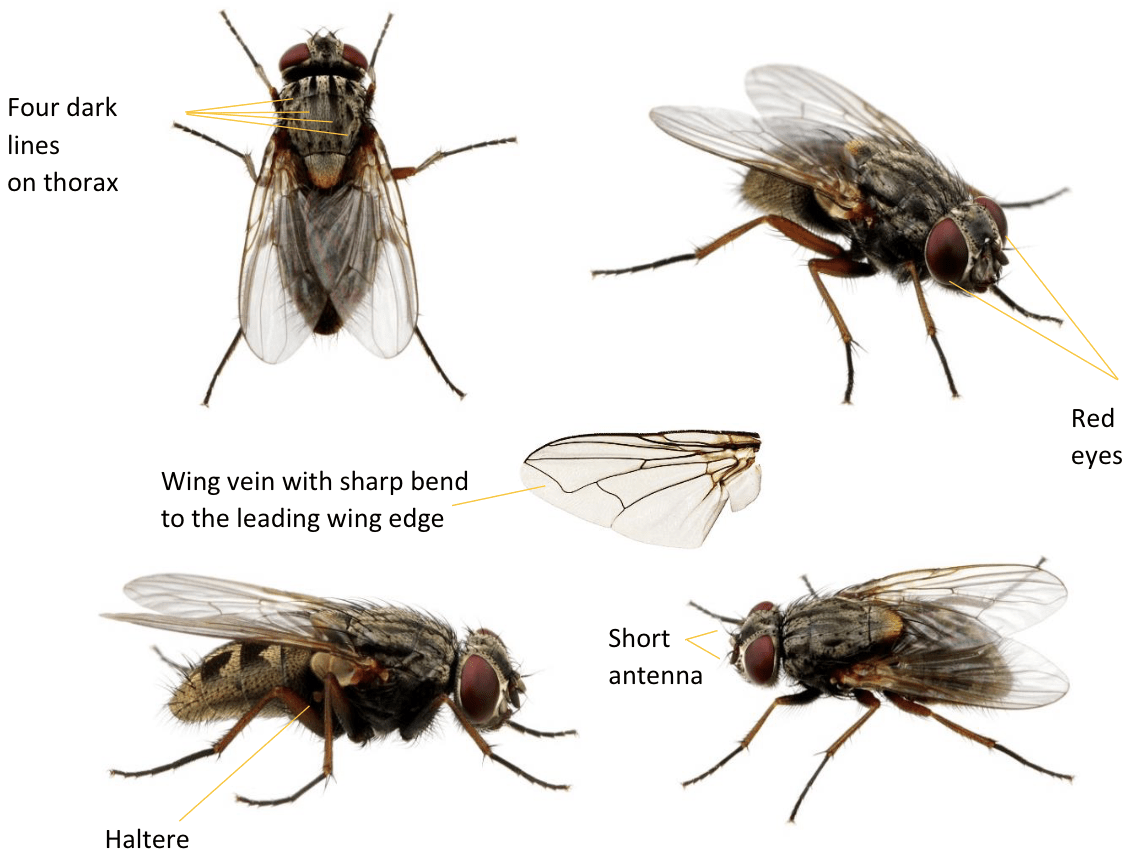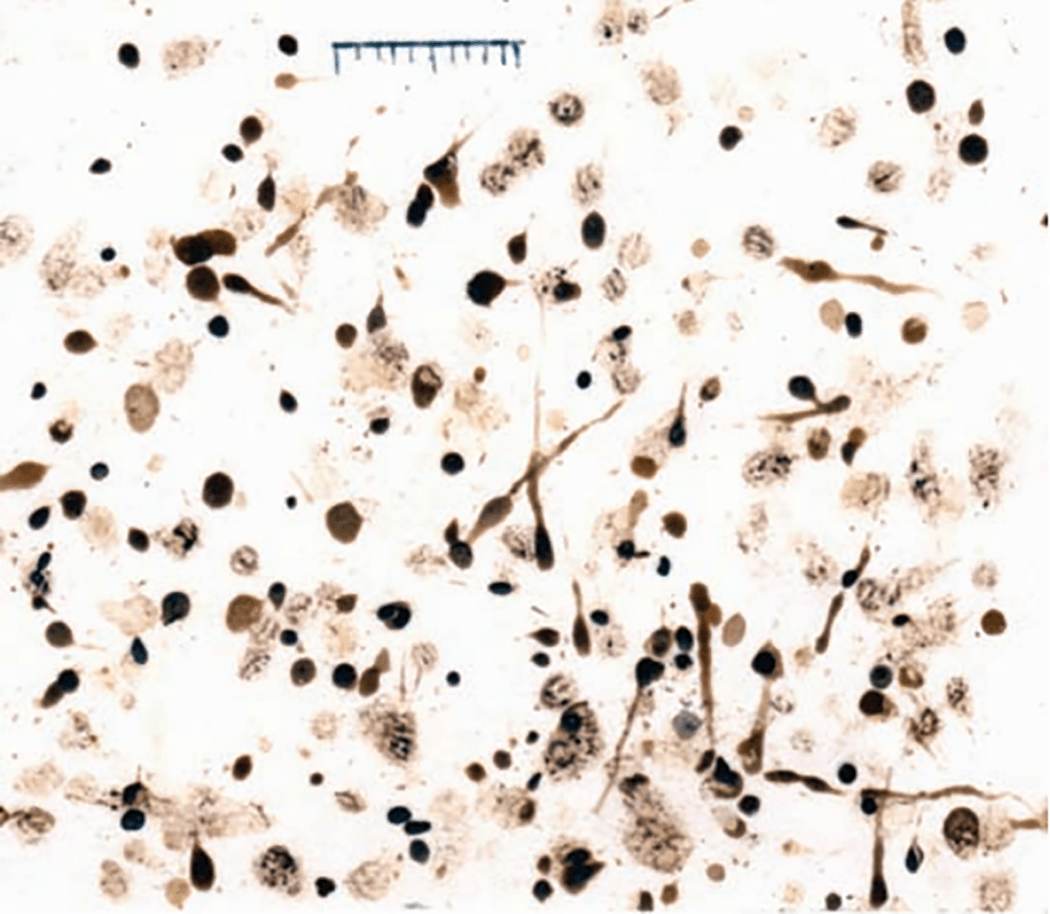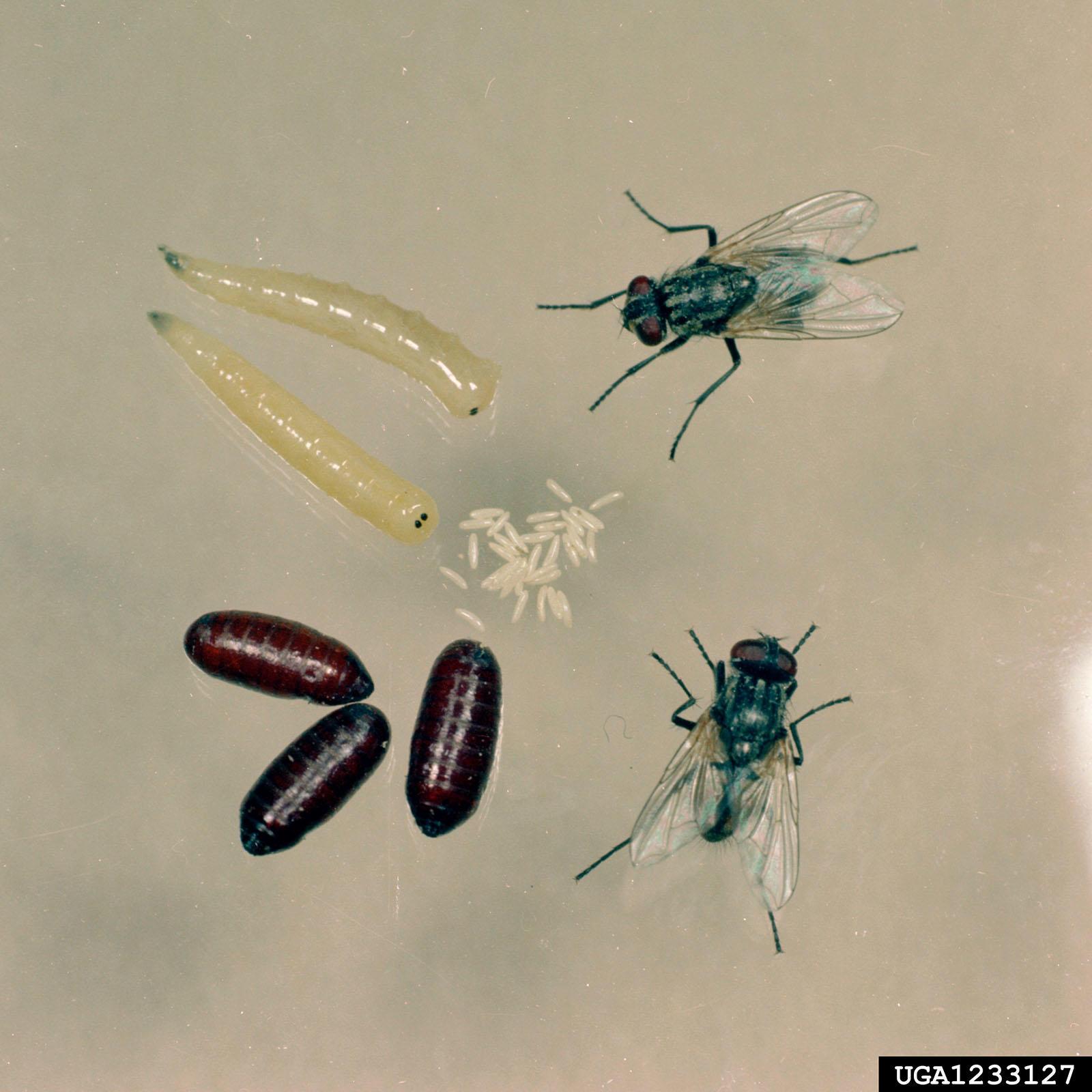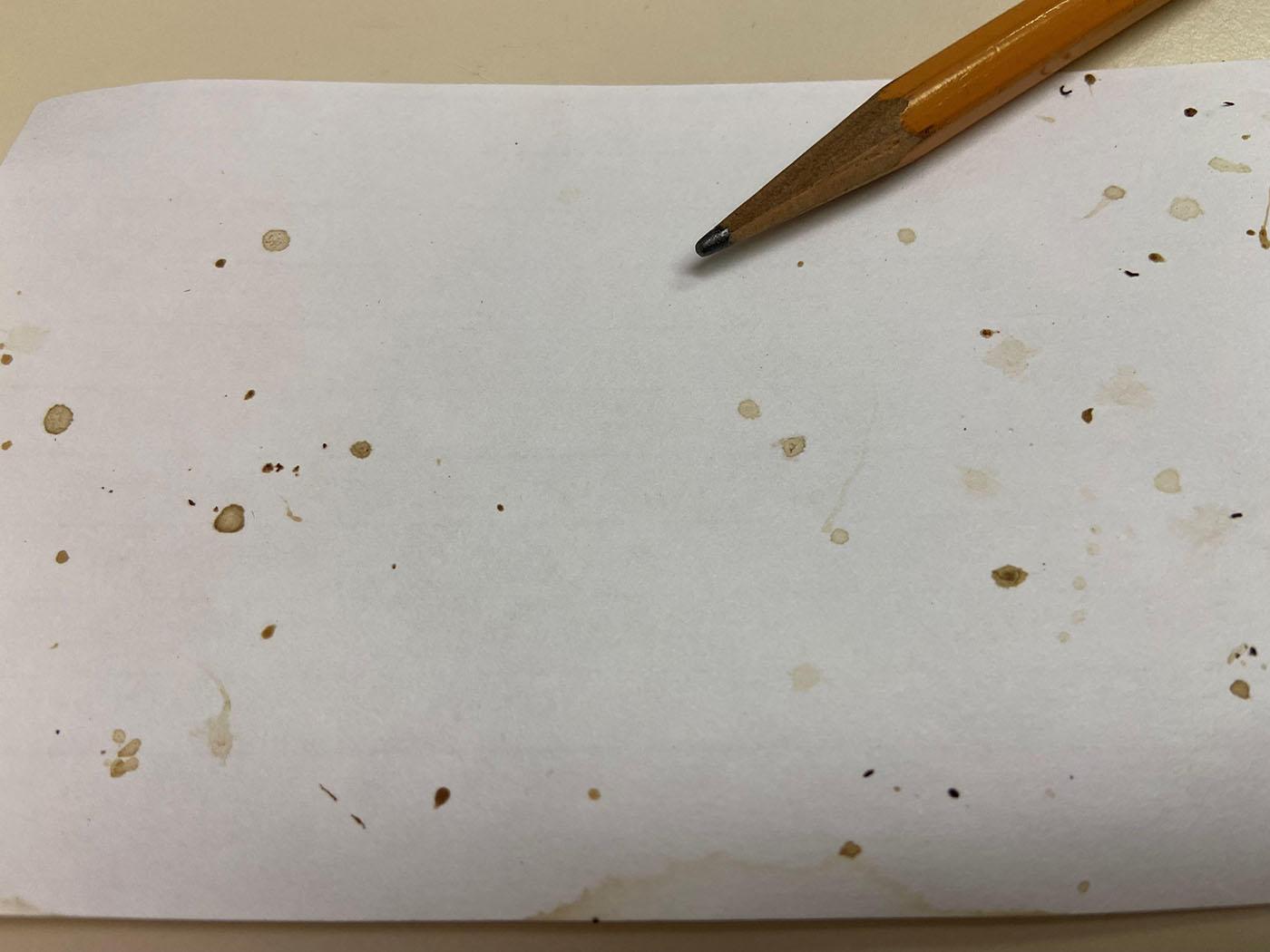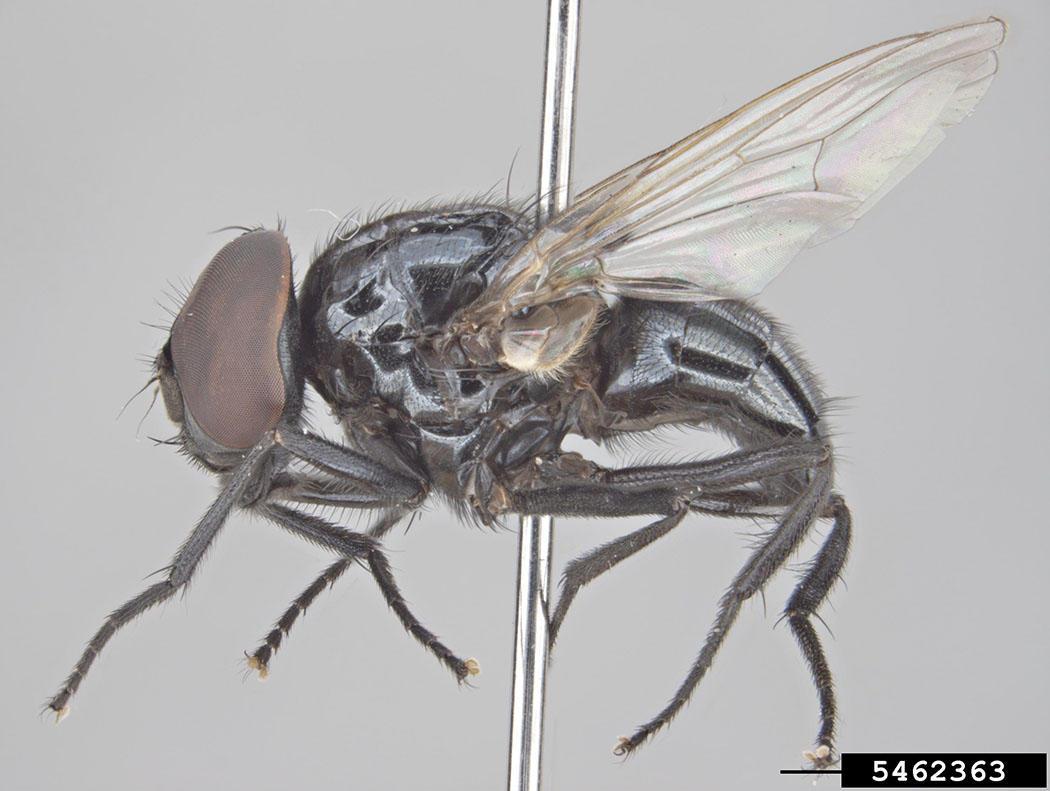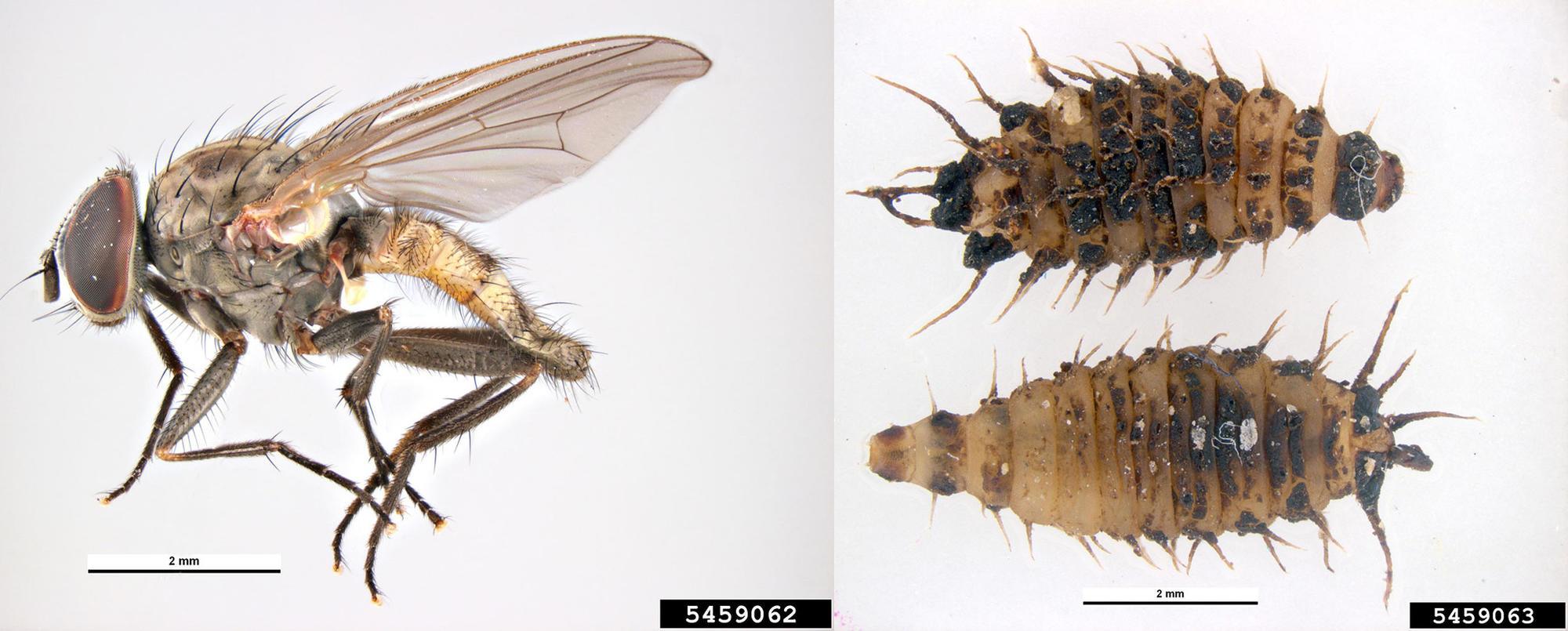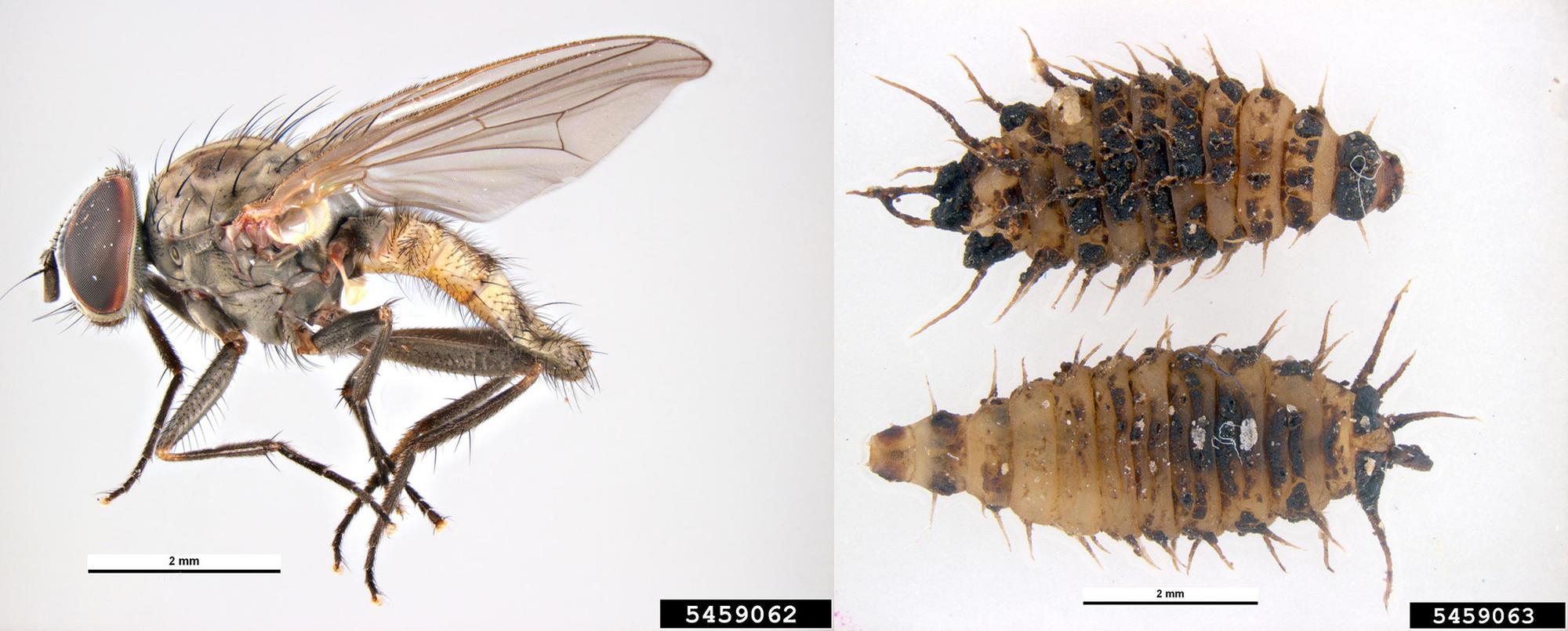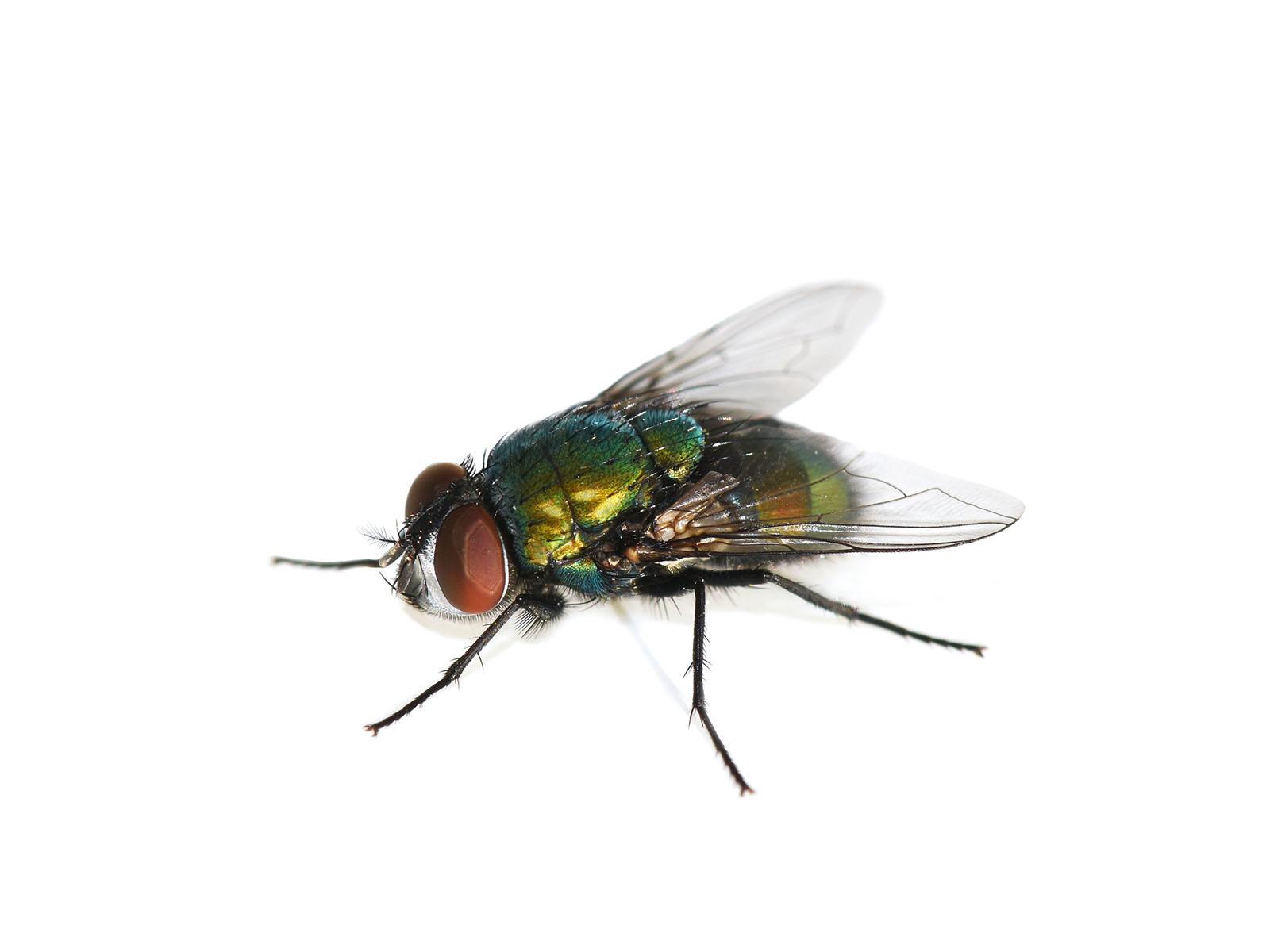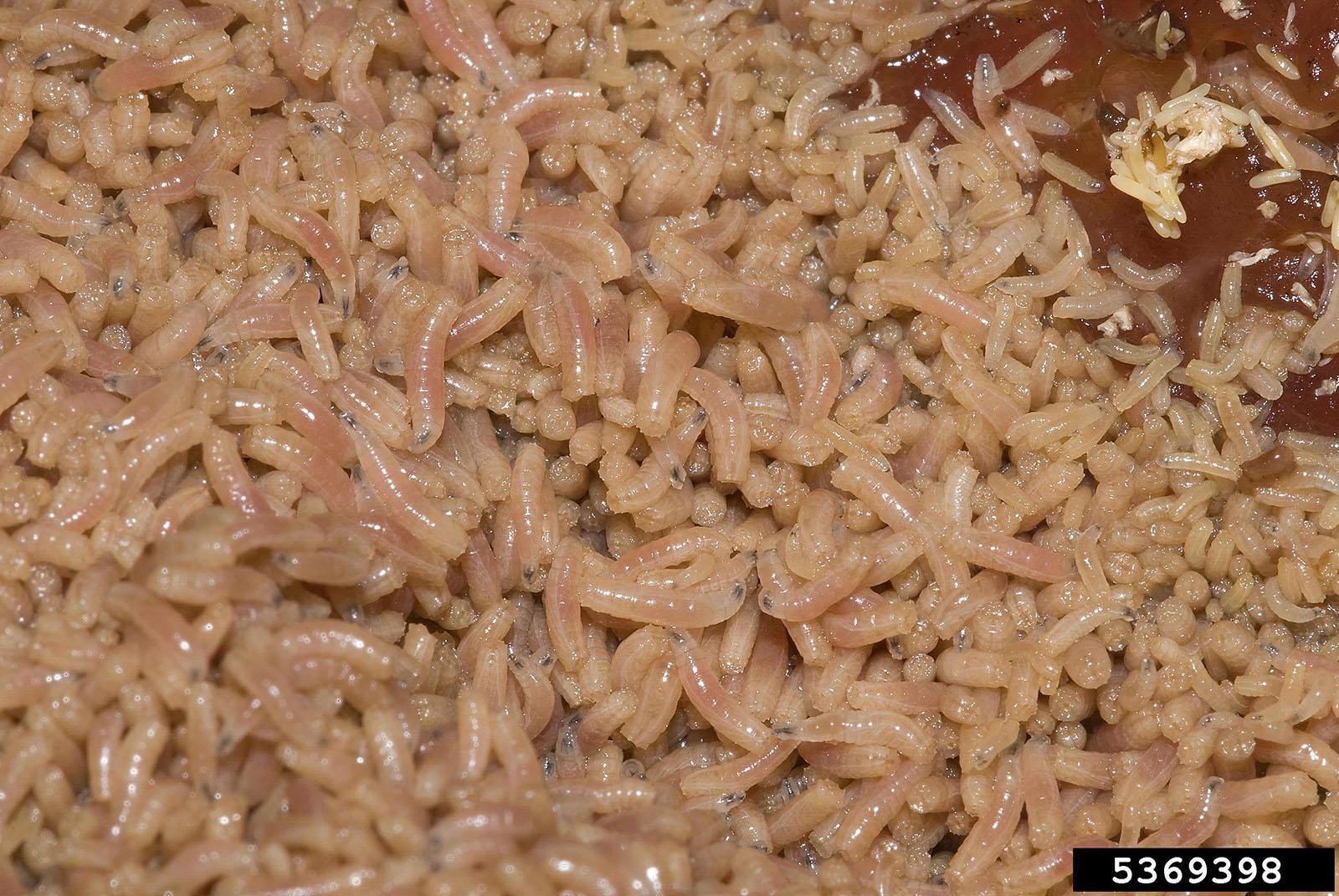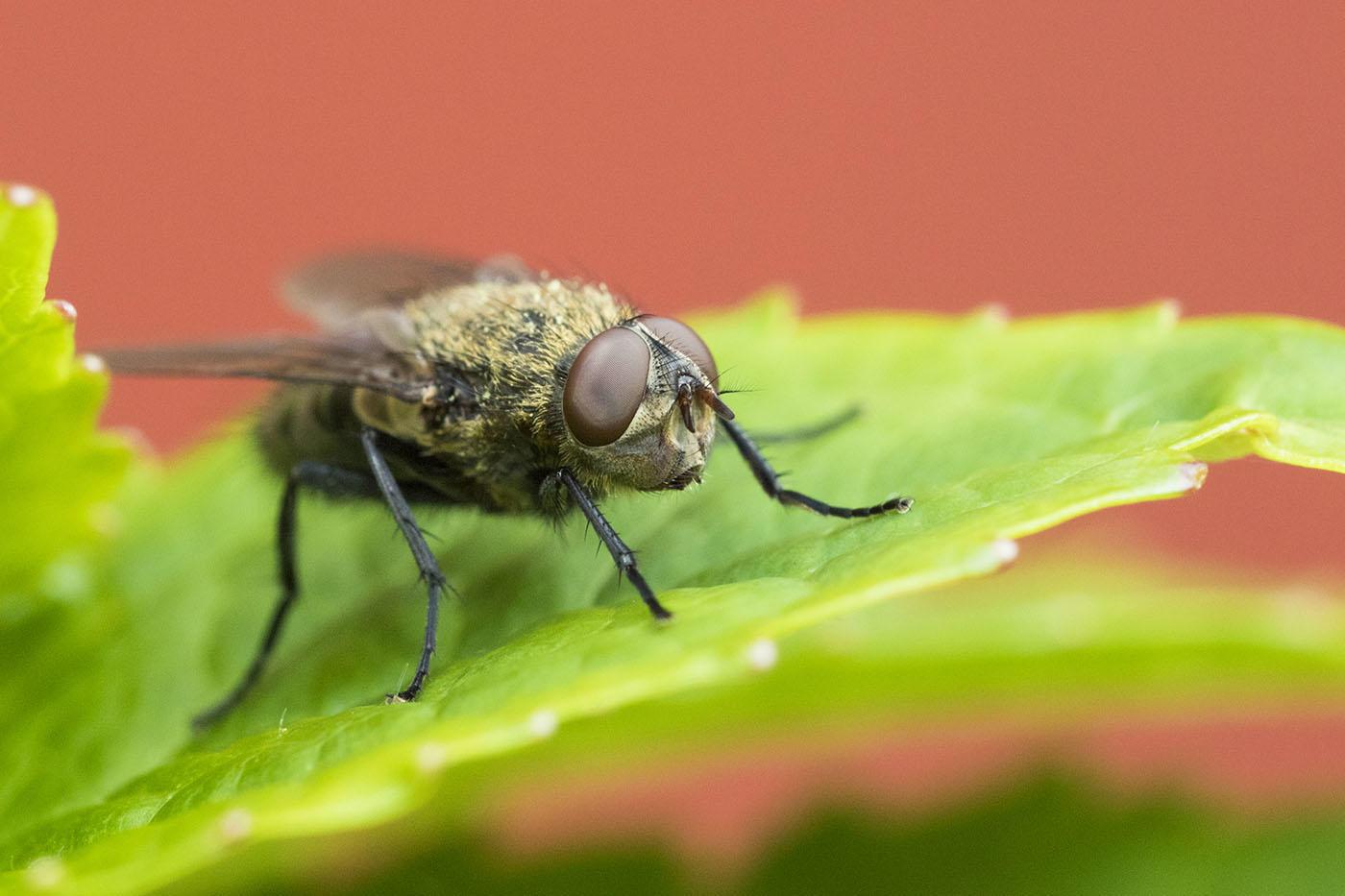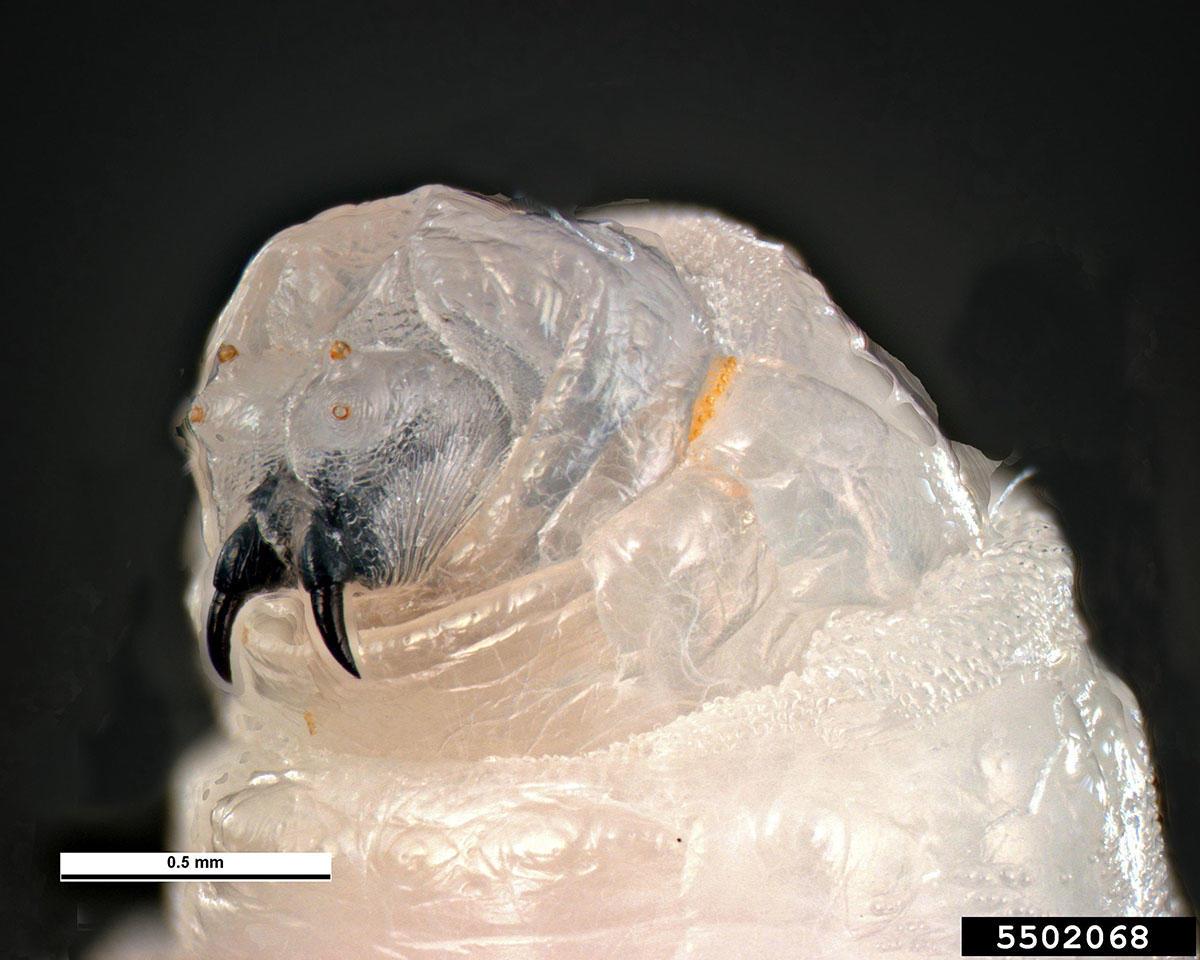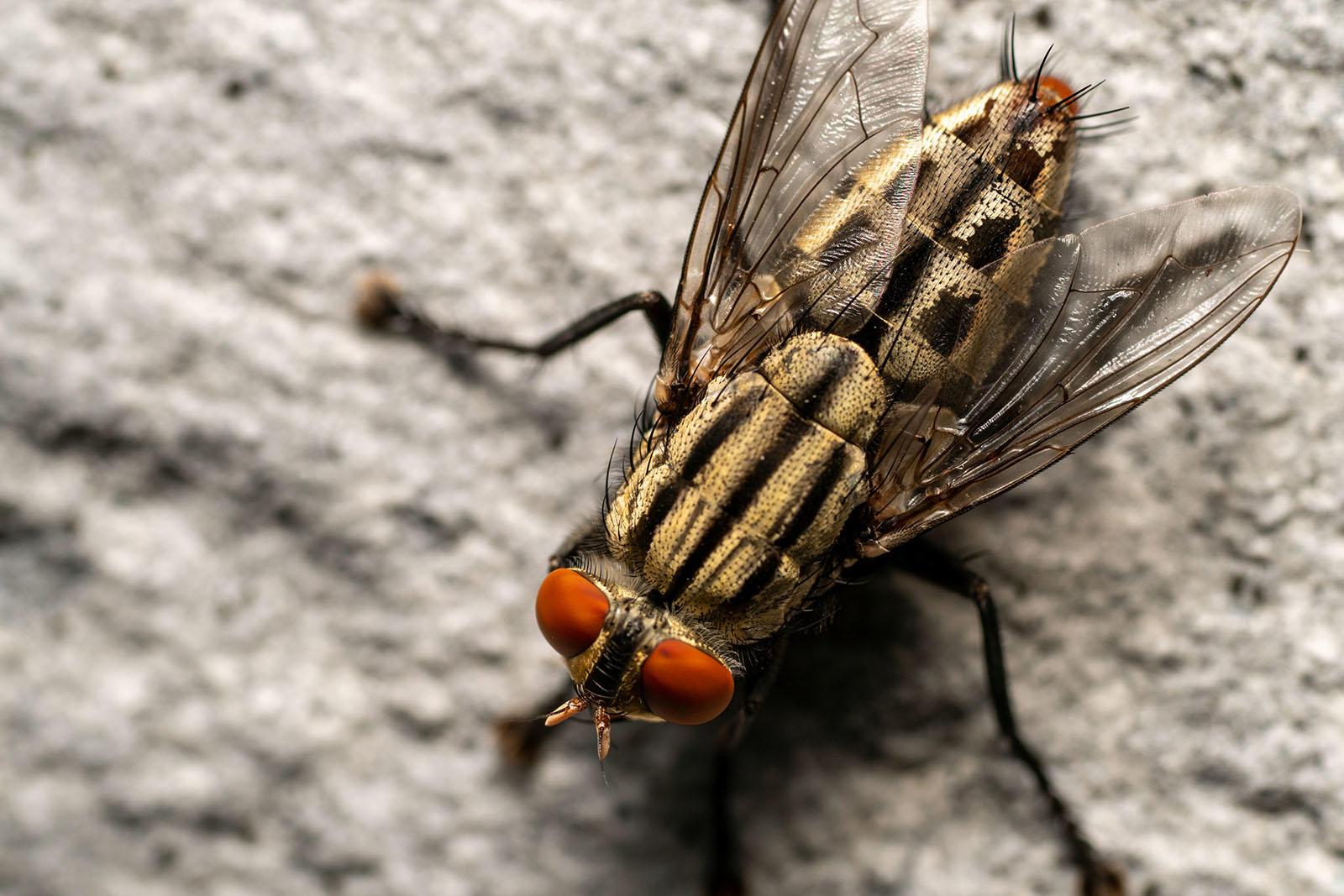Introduction
Many kinds of flies are found in and around school grounds. Only some are problematic, and many are considered beneficial. In the Pacific Northwest, hover flies (also called syrphid or flower flies) are common in fruit tree orchards, gardens and school landscapes (Figure 1). Hover fly adults are important pollinators of wildflowers in many ecosystems, and the maggot-shaped larvae are voracious predators of aphids, scale insects and thrips. Adults are sometimes mistaken for wasps or bees as they are brightly colored and somewhat stripy. However, like all flies, they only have a single pair of membranous wings and no stinger.
Contents
- Introduction
- Indoor species
- Fruit flies
- Phorid flies
- Drain flies
- Darkwinged fungus gnats
- Things to consider in managing flies that reproduce indoors
- Managing flies that reproduce indoors
- Flies that invade from outside
- House fly
- Dump flies
- Little house fly
- Blow flies
- Cluster fly
- Flesh flies
- Managing flies that invade from outside
- Resources
Flies develop through complete metamorphosis. Many pest species lay eggs, but flesh fly females deposit small larvae. Fly larvae, commonly referred to as maggots, are in an actively feeding stage and grow through a series of instars, molting their outer cuticle each time they transition to the next instar. Some species move away from food resources as last instar larvae and then pupate as a sedentary, nonfeeding form. Adult flies emerge if environmental conditions are favorable.
Unfortunately, many flies that enter or develop in kitchens, food storage, service and consumption areas are not only annoying pests, but potential public health risks.
Numerous disease-causing pathogens (germs) are associated with common fly species that develop in and feed on garbage, animal excrement, carcasses and drain sludge. These environments are rich in bacteria, viruses, protozoan and helminth (worm) pathogens. Adult flies can transport pathogens on their feet and bodies to food, food-processing equipment and food-contact surfaces. However, the highest pathogen transmission risks are associated with fly species that digest their food outside of their body in the adult stage. Many insects and spiders use extraoral digestion to break down and liquify their food before they consume it. Fly species that use this method of digestion deposit regurgitated stomach content high in digestive enzymes onto food substrates. These flies have sponging mouthparts that are used to sponge up a liquid meal. Pathogens inside the gut are deposited along with the gut content. Moreover, several pathogens can remain infectious for longer in the gut than on the surface of the fly’s body. Additionally, flies will deposit fecal spots containing pathogens.
Specific fly species have been known to spread some serious disease-causing pathogens. Transmitted bacteria include Escherichia coli, Salmonella, Shigella and Listeria. Transmitted viruses include hepatitis A and rotavirus. However, flies in the Pacific Northwest are most likely to spread pathogens that cause stomach upsets and diarrhea. Only some flies included in this publication are documented pathogen transmitters, and some are not extraoral digesters. If a specific fly or group of flies has been documented to transmit disease-causing illness in the U.S., the potential pathogen risks have been noted.
Several common fly species that feed on dead and decaying organic matter are also attracted to the wounds of living animals, including people. Eggs (or larvae) laid under bandages or on delicate skin can lead to fly larvae feeding on human tissues. Some species feed on dead tissues, and some damage live tissue. Myiasis is a term used to indicate a fly infestation of a living person or other animal. This is of particular concern for those with injuries, peripheral vascular disease, invasive medical devices, and wounds associated with diabetic or decubitus ulcers (pressure sores). People who use wheelchairs and those with prosthetic limbs may be particularly vulnerable. Blow, flesh and phorid flies are the most common groups involved in human myiasis, and there are rare cases of drain fly infestations.
In this publication, we group flies into two broad categories: those that complete their life cycle indoors and those that usually complete their life cycle outside but move into buildings through open doors and windows. A few species readily do both. This publication provides identification characteristics, basic biology, associated health risks, monitoring and management strategies for common pest species. When the management information for controlling flies is specific to a fly group or family, the information is addressed within that section. General management guidance for flies most applicable to those developing outdoors can be found in the last section of this document.
Indoor species
Fruit flies (lesser fruit, pomace, vinegar or bar flies), family Drosophilidae
Several species of fruit flies in the Pacific Northwest are found in kitchens. Drosophila melanogaster is found around ripe, picked or fermenting fruit, vegetables, mushrooms and moist organic matter in and around buildings. Drosophila repleta is attracted to rotting organic matter and is strongly attracted to biofilms where moisture is consistent and a buildup of organic matter exists.
Fruit fly adults are small, between 1 to 3 mm in length, with rounded abdomens and clear wings. Most are light brown to black, with paler bodies on the underside. Live Drosophila adults have reddish eyes. Drosophila melanogaster has bright red eyes, pale reddish-brown bodies with darker bands across the top of each abdominal segment, and the abdomen gets darker toward the posterior end (Figure 2). Drosophila repleta adults have black speckles on their upper thorax, dark red eyes and darker wings (Figure 3).
Female flies lay eggs on or near suitable food. Larvae grow through three instars and pupate in or on their food substrate, emerging quickly as adults. At temperatures of 80°F eggs can hatch and develop into adults in just a week.
Fruit flies are strong fliers, able to travel 9 miles in a single trip. Outdoors, adult flies are most active during warm, sunny days. Populations peak during summer months with plentiful rain or irrigation. Adults feed on the sugary fluids from fruit, plant nectar, honeydew produced by plant-feeding insects, and decomposing carcasses. Indoors, they are more active in lower light areas and can go unnoticed until population numbers increase.
Fruit flies are extraoral digesters, meaning that breakdown of food occurs outside the insect body. The fly regurgitates enzymes from the salivary glands and gut onto the food source, then sucks up the liquefied meal using sponging mouthparts. Fruit flies have been documented transferring Escherichia coli, Salmonella and Listeria to food preparation surfaces and Escherichia coli onto ready-to-eat food. Additionally, fruit flies can cause short periods of enteric myiasis. This is a condition in which food infested with fly eggs or larvae is eaten and the insects survive in a person’s digestive tract. Actively feeding larvae can survive long enough to cause stomach pain, nausea and vomiting.
Determining where Drosophila are emerging from indoors can be challenging. Small plug-in UV light traps with sticky capture boards (Figure 4) can help to determine where adults are most numerous. This can narrow down the locations in which larvae are developing. However, great care should be taken to avoid placing these UV light traps near water splash areas, such as under dishwashing equipment or near sink locations.
Food-based lure traps come in various designs (Figure 5) and may be useful in some situations. Many use dilute acetic acid (vinegar) as a lure. However, discourage the use of homemade funnel traps or cellophane catch-traps with fruit inside. They trap only some flies effectively and can ultimately generate more fruit flies.
Check for decomposing fruit and vegetable matter in kitchen equipment and hard-to-reach areas. Also, check for spilled food mix around stand mixers. All moist areas in kitchens must be kept scrupulously clean. Organic matter biofilms, which create areas for fruit flies, form quickly in floor and sink drains, sink overflow drains and garbage disposals. They also form in areas with plumbing or roof leaks, under antiskid floor mats and in damaged grout, floor and wall tiles in damp areas. This is especially true near dishwashing equipment where warmth, moisture and organic matter are in constant supply.
Check loose-lidded vinegar and fruit juice containers stored for recycling, and frequently inspect floors and drains for organic matter and biofilm buildup.
The invasive spotted wing drosophila, Drosophila suzukii (Figure 6), is established in the Pacific Northwest, and this species attacks ripe stone fruit and berries still on plants, as well as overripe or decaying fruit.
Phorid flies (humpedbacked, coffin, scuttle flies), family Phoridae
The Pacific Northwest has many species of phorid fly. Commonly encountered species in and around buildings are small, between 2 and 3 mm in length, yellow, tan or dark brown with an arched thorax and distinct humpbacked profile. Adults have spiky hairs on the face and head and a distinct wing vein pattern that easily separates them from other indoor-infesting small flies (Figure 7).
Phorid flies run around on surfaces and fly in an erratic zig-zag fashion. Eggs are oval and develop rapidly to adult stages in 12 to 28 days, depending upon conditions. Larvae grow through three instars to around 10 mm in length but are rarely visible unless the substrate they are developing in is disturbed. However, groups of pupae can be found clustered close to larval feeding sites (Figure 8).
Phorid flies are attracted to a range of food resources. They have been found feeding on some unusual resources, including modeling clay and emulsion paint. Organic materials more commonly used as food include carrion, decaying plants and fungi, rotting food scraps, animal feces, mixed garbage, sanitary towels in disposal bins, moist landscape clippings and compost.
Septic system overflow and sewer plumbing leaks can lead to sewage-contaminated soil under and around buildings, which can become heavily infested with phorid flies. This sometimes necessitates major reconstruction of flooring and foundations.
Female phorid flies often lay eggs in cryptic (hard-to-see) locations, so larvae can be challenging to locate. As with other small, indoor-infesting flies, small plug-in UV light traps with sticky capture boards can help find where flies emerge (Figure 9). Adult flies are attracted to light and can be found on window ledges and near ambient lighting.
Phorid flies are more common during warm months, but indoors they can persist year-round. Populations build up quickly.
Phorid flies are considered a public health threat in food-handling locations. Adults have sponging mouthparts and consume liquid meals, but none have been documented regurgitating before feeding. They have been observed defecating on substrates they land on, and because of the unsanitary places they develop in and feed on, they have been investigated as potential pathogen transmitters. The genus Megaselia has been documented carrying Escherichia coli, Salmonella, and Staphylococcus aureus on adult fly legs. Thus, they are potential pathogen transmitters. However, more research is warranted on their ability to transfer pathogens onto food and surfaces.
The coffin fly, Megaselia scalaris (Figure 10) is a phorid fly species common in buildings. Adults can burrow through several feet of soil to access organic matter and can generate infestations that necessitate costly remediation.
Combine strategies to manage phorid flies. Inspect for and remediate biofilms forming in moist areas. Use foaming microbial cleaners to dissolve organic buildup in drains and other areas. This is most important in kitchens and campus eating areas. Don’t apply bleach or other disinfectants, which are not effective. The combination of bleach and hot water releases dangerous chlorine gas.
Inspect drains with a flexible borescope (Figure 11) or use smoke in plumbing lines to help locate pipe fractures. Repair plumbing breaks under concrete slabs and remove all infested soil . Inspect the wall, floor and ceiling voids, basements and soil in crawl spaces to determine if birds, reptiles or small mammals have died in those areas. Phorid flies can develop on animal carcasses and fecal and nesting materials.
Check garbage cans and diaper pails in high school child care facilities; these can serve as epicenters of phorid fly emergence.
Inspect all classroom pets and enclosures. Check all animal enclosures, including insect, tarantula, hermit crab, reptile and small mammal enclosures. Phorid flies are often found developing in animal terrariums and cages and may injure living animals.
Drain flies (moth, sewer flies), family Psychodinae
Several drain fly Psychoda species can be found in the Pacific Northwest. Common species are small, with adults that measure 2 to 4 mm in length. Flies are greyish-tan to dark brown (Figure 12). They are densely covered with fluffy hairs, resembling small, moth-like creatures. Some have subtle patterns on their wings. They have long, fuzzy antennae. Adults are weak fliers and make erratic short flights. The flies are attracted to light when they first emerge and you may see them resting on windowsills. But after mating, they begin to avoid light and move higher off the ground (negatively geotropic). You may see them during this stage on white or light-colored tile on bathroom and kitchen walls. Adults are most active during the evening and nighttime.
Eggs are tiny and unlikely to be visible. They are laid in groups of 10 to 40. Larvae are also rarely seen unless the substrate they are developing in is disturbed. Larvae develop through four instars remaining hidden in biofilms of gelatinous slime that accumulate on the side of kitchen drains, shower drains, toilet drains and overflow drains in sinks. They feed on algae, bacteria, fungi and other microscopic organisms, then pupate within the biofilm layer. Larvae have long-breathing siphons (tubular structures) that extend through slime layers into the air (Figure 13).
Adult flies emerge from many locations, including drains, moist garbage, tree holes, raw sewage and septic tanks, fish tank filter media, aquaria trickling filter systems, condensate pans with algal growth and wet compost. Larvae can trap air bubbles and withstand long periods in low-oxygen media. Development is rapid with eggs hatching and developing into adults in just two weeks at 70°F.
Adult fly mouthparts are reduced, and life history descriptions indicate that adults consume only small amounts of liquid. Reports show the drain fly species Psychoda alternate can carry Clostridium difficile on the outside of their bodies. This bacterial pathogen causes diarrhea in humans and other animals. However, little is known about their ability to transfer pathogens onto food and surfaces.
Allergic rhinitis, asthma and skin reactions are also reported as individuals may become sensitized to drain fly allergens.
To tell if flies are coming from a drain, cover the opening with clear tape or a clear plastic container with one or more sticky monitoring cards taped to the top or sides (Figure 14). Leave the covering in place overnight or for a few days to catch any emerging flies. Flies can emerge from more than one location.
Darkwinged fungus gnats (sciarid flies), family Sciaridae
There are multiple species of Lycoriella and Bradysia darkwinged fungus gnats in the Pacific Northwest. Adults are small, slender flies about 3 mm in length with long legs and antennae (Figure 15). They are black and often seen running around on the soil of potted plants. Darkwinged fungus gnat larvae are white with shiny black head capsules (Figure 16) and grow to 6 mm long. Fungus gnats are well-adapted for completing their lifecycle inside buildings, given conducive conditions, or outside. They can be a nuisance in either location.
Fungus gnats infest moist, organic environments that support fungal and algal growth. In classroom and office areas, females lay eggs in the soil of potted plants. Larvae develop in the soil eating fine plant material, algae and fungi in or on the soil. After four larval instars, they pupate in the soil. At 75°F, they complete their growth from egg through four larval instars, pupate and emerge as adults in under three weeks. Adults are weak flyers but are attracted to light traps.
There are few accounts of adult fungus gnats feeding, and reports describe adults feeding on plant nectar or not feeding at all. They do not deposit salivary regurgitate on surfaces and are not considered a significant health risk under normal conditions. However, it is a good idea to avoid potted plants in kitchen and food preparation areas.
Overwatering indoor plants causes the flies to proliferate. Also, avoid allowing water to sit in saucers under plants, as algae can begin to grow and serve as a food source. Clean out potted plant saucers, removing all algal buildup regularly. Keep mulch and bark levels in potted plants to a minimum and remove fallen leaves and flowers from the soil surface. Allowing potted plants to dry out will dramatically reduce fungus gnat survival. If the plants cannot survive dry conditions treat them with biocontrol agents, such as Steinernema feltiae, an entomopathogenic nematode, Bacillus thuringiensis israelensis (Bti), a toxic bacterium or Beauveria bassiana, a fungal pathogen. Note that microbial products like Bti and fungal pathogens are registered pesticides.
Any moist area that supports mold and algae creates habitat for fungus gnats to infest. Even without potted plants, fungus gnats can use areas where moisture is common, including kitchens, bathrooms, utility rooms, custodial closets and areas affected by plumbing or roof leaks. Correcting moisture problems and cleaning fungal and algal growth will eliminate infestations.
In campus landscapes and greenhouses, larvae can build up in number due to organic matter, irrigation, or rainfall supporting fungal and algal growth. Fungus gnats can proliferate in gutters and drainage pipes clogged with vegetative debris. Regularly clear and screen gutters and downspouts to reduce the buildup of organic matter around buildings.
Turf grown in high organic soils and heavy thatch encourages darkwinged fungus gnat populations to increase after rainy periods. Organic mulch can exacerbate the situation. Improving the aeration of turf and reducing organic input, thatch and irrigation reduces larval survival. Larvae sometimes cluster and migrate above the ground (Figure 17). They are most noticeable when moving across sidewalks and driveways.
Things to consider in managing flies that reproduce indoors
- Most outdoor fly species peak during the warmer months.
- Identify flies caught in monitoring traps to help to determine if they are entering from outside or if you have interior infestations. Your county Extension Service can help with fly identification.
- Broad-spectrum insecticide spraying or space treatments are rarely successful in eliminating fly infestations. They should not be used in a school setting. The solution lies in resolving the conditions supporting fly reproduction. In rare instances when there are large populations of flies indoors, pesticides may be used to reduce the numbers until you have identified the sources.
- Flies reproducing indoors may be emerging from locations which are not always immediately obvious.
Managing flies that reproduce indoors
- Follow pest exclusion best practices. Replace weatherstripping, seal cracks around conduits and fit snug door sweeps and window screens. Keep in mind the small size of indoor infesters. Use a mesh size of 18 x 18 in window screens to exclude most smaller fly species.
- After plumbing repairs or replacements, ensure all unused pipes have been cleaned and capped. Uncapped plumbing pipes containing waste in dropped ceiling or wall voids can generate an endless supply of phorid flies, drain flies and others.
- Repair and reseal loose and cracked tiles. Some fly species can develop in moist organic matter buildup beneath flooring, in missing grout lines or in flooring cracks.
- Check that soda and frozen dessert dispenser drip trays are kept clean and dry. Check inside counters, below and behind dispensers for spills or broken syrup containers.
- Check that kitchen floor sinks and food preparation areas are fitted with metal catch baskets. They help to reduce the amount of organic matter washed down floor drains, reducing organic matter buildup. Wash baskets daily, many can be cleaned in the dishwasher.
- Routinely deep clean floor drains. This is an essential kitchen sanitation activity. Use a bacterial or enzymatic drain cleaner, followed by hot water. Avoid using caustic drain cleaners (such as lye-based cleaners containing sodium hydroxide or potassium hydroxide). They are not as effective as enzymatic cleaners. Only undertake manual cleaning with a stiff brush if the kitchen is not in use. Thoroughly clean and disinfect all food contact surfaces and equipment after manual drain cleaning in the kitchen. Cleaning with brushes or scrapers can aerosolize Listeria bacteria in moisture droplets that settle out on surfaces.
- Look for watermarks on ceiling tiles and walls. These indicate leaks that could allow flies to develop in wall voids.
- Thoroughly launder or clean and hang mops and cleaning tools to facilitate rapid drying. Some fly species can develop in moist, dirty mops and brooms.
- Frequently inspect potted plants and pet enclosures in classrooms, including fish tanks and other aquaria and enclosures for insects, tarantulas, hermit crabs, reptiles and small mammals.
Good kitchen sanitation includes the remediation of biofilms in drains to avoid drain-developing flies. Regular maintenance of drains using enzymatic cleaning agents that digest the organic matter completely away from the interior surfaces is by far the most effective approach.
Flies that invade from outside
House fly, Musca domestica, family Muscidae
House flies are the most commonly encountered fly species around schools. The species is found throughout the U.S.
Adults are 4 to 8 mm long, gray, or yellowish and black (Figure 18). They have red eyes, short antennae and sponging mouthparts. There are four dark, longitudinal lines on the top of the thorax. The abdomen is gray or yellowish with a dark midline and irregular dark markings on the side of females and a yellowish underside on males. Both adults have a darker median line on the underside of the abdomen. Their bodies are sparsely covered with hairs and have a single pair of membranous wings. The wing vein pattern is distinct, with the fourth longitudinal wing vein bending sharply to the leading wing edge. Males are slightly smaller than females.
House flies use various food sources, including human and animal food, excrement, garbage, and decaying plant and animal remains. House flies are extraoral digesters and leave both regurgitate and fecal deposits on surfaces they land on (Figure 19). As a result, their body surfaces become contaminated with pathogens that can mechanically transfer to food. House flies are known to transmit Salmonella, Shigella, Campylobacter, Escherichia, Enterococcus and Chlamydia, and they are implicated in numerous outbreaks of diarrhea and shigellosis.
House flies generally reproduce outside and usually become indoor pests if external doors are propped open or windows are not screened. They are strong flyers capable of traveling several miles but usually remain within a mile of their development site. They overwinter as larvae or pupae, and adults emerge once spring temperatures increase. Females produce clutches of 100–150 eggs in high-moisture (about 60% relative humidity), nutrient-rich, decaying organic matter. There are three larval instars, the last growing to approximately 13 mm (Figure 20). Development from egg to adult can be as short as a week in tropical locations. Still, it may take a month or longer in the Pacific Northwest, depending upon temperature conditions. House flies are notably more prevalent during warmer summer months.
Indoors, house flies are active during the daytime and are attracted to UVA light passing through windows. Ambient LED lamps produce tiny amounts of UV and are generally considered to be the least attractive lamps to flying insects in general. Fluorescent lamps also emit tiny amounts of UV light and can attract flies into light housings in ceilings.
Outdoor campus agricultural facilities may require an active house fly monitoring and management plan.
Monitoring insect activity at campus agricultural facilities can be a rewarding and engaging learning activity for students. One goal of monitoring is to know when fly activity exceeds an action threshold. Another is to evaluate interventions aimed at reducing nuisance populations and potential pathogen transmission.
Monitoring tips for house flies in outdoor campus agricultural facilities
- Nonpesticidal light traps that use UV light and sticky capture boards are ideal for removing house flies from the indoor environment. They also work well for monitoring purposes.
- Trap flies using a monitoring device that captures flies over the period of a week. This is a better indicator of population levels than comparing trap counts collected over a shorter period.
- Increasing the number of monitoring devices increases sampling precision.
- There may be multiple seasonal peaks in population activity throughout the year.
- Sticky fly strips can be hung in sheltered or enclosed agricultural locations inaccessible to animals. They are inexpensive and attractive to house flies and other common flies. However, they need to be replaced frequently in dusty environments.
- Fly strips are not recommended for use in unsheltered agricultural locations, or in other locations where dust, direct sunlight or high winds are expected.
- Yellow sticky traps can be used similarly to fly strips. The traps are sturdier but more expensive.
- House flies are attracted to the color white, and you can use the unlined sides of white index cards, pinned to shelter supports can be used to collect fecal and regurgitation spots. Spots can be recorded as a relative activity measure. Multiple fly species will deposit defecatory and regurgitation spots (Figure 21). Calculate overall fly data in spots per square centimeter per week.
- Hanging bag traps with nonpesticidal lures can be effective collectors of flies, but many smell unpleasant. Only use these traps far away from agricultural buildings; they are not suitable collection traps for students to use if they are counting flies as part of a project or for recordkeeping.
Dump flies (garbage flies, Hydrotaea species), family Muscidae
Several dump fly species in the Pacific Northwest can become more prevalent than house flies, given warm conditions and a buildup of garbage or a local poultry-rearing facility. Dump flies are small, about 6 mm long, and generally have dark, shiny or metallic-looking bodies (Figure 22). The black dump fly develops quickly on bird excrement and has been used as a biocontrol agent of house flies. However, they can become so numerous that they can also become a problem. The last instar larvae of the black dump fly (Hydrotaea aenescens) are omnivorous and predators of house fly larvae. They are strongly exophilic meaning that they live outside buildings and will rarely enter unless accidentally moved indoors. Females lay eggs primarily on manure, carrion and mixed garbage scraps. They have been documented carrying Salmonella enterica serovar Infantis, one of the most important foodborne pathogens causing human diarrheal disease.
Little house fly, Fannia canicularis, family Fanniidae
The little or lesser house fly is found throughout the U.S. Adults (Figure 23) are grey and black, measuring 5–6 mm in body length. They have reddish eyes, three subtle dark longitudinal stripes on the thorax, and a narrower abdomen when compared to house flies. The species shares many life history traits with the house fly, including the fact that larvae (Figure 23) develop in moist decaying, nutrient-rich organic matter including animal feces. While house flies favor garbage and excrement, little house flies will use moist, decomposing plant matter to lay eggs in, including moist grass clippings.
Adult males aggregate in mating swarms approximately 1.5 meters off the ground in locations that provide shelter from wind and direct sun. They can move from development sites over two miles away to external building entryways on campus. The little house fly has sponging mouthparts and has been documented transmitting multiple disease-causing pathogens. These include an exotic Newcastle disease virus to poultry and several bacterial pathogens that impact human health including Campylobacter spp., Enterococcus spp., Staphylococcus aureus and antimicrobial-resistant strains of Pantoea spp.
Blow flies (bottle flies), family Calliphoridae
There are many blow fly species in the Pacific Northwest. Commonly occurring species are 8 mm or larger as adult flies. Many species are metallic blue, green (Figure 24) or bronze. Species most common around schools lay eggs on decomposing animal carcasses, excrement and meat waste in garbage. Some species find dead animals quickly including rodents, birds or other animals that occasionally die in or around school buildings. The presence of blow fly larvae or multiple flies indoors indicates that an animal may have died somewhere inside (Figure 25). Blow fly larvae (Figure 26) will wander away from a carcass before they pupate.
Blow flies have sponging mouthparts, are extraoral digesters, and are strongly attracted to human food and waste. They have been documented as carrying and transmitting numerous disease-causing pathogens acquired from garbage, carcasses and animal feces and subsequently depositing them on food and surfaces. Pathogen concerns include but are not limited to Calliphora species carrying avian influenza viruses and the widely distributed calliphorids Lucilia sericata (greenbottle), Chrysomya megacephala (oriental latrine fly), and Calliphora vicina (bluebottle), documented as having the highest potential for pathogen transmission. All species are common in the Pacific Northwest.
While many fly species deposit regurgitate droplets to facilitate extraoral digestion, common blow fly species have repeatedly been observed generating bubbles of regurgitation (Figure 27). Flies can be observed exuding a bubble of liquid from their mouthparts, then repeatedly sucking the liquid back in and out before depositing the droplet. Several benefits result. Scientists have documented that the habit facilitates thermoregulation (regulate their own internal temperature) when flies are exposed to high ambient temperatures. Additionally, bubbling increases the concentration of enzymes in regurgitate which may be a response to help meal digestion. The habit also increases the chance of transmitting disease-causing pathogens in the regurgitate that is deposited on food.
In general, blow flies are strong flyers and travel many miles from their original developmental site. They are most abundant during the warmer months when they can reproduce quickly. They can develop from egg to adult in under a month in ideal environmental conditions.
Adult flies entering buildings remain active during the day and are strongly attracted to light, so they are often found next to windows.
Cluster fly, Pollenia species, family Calliphoridae
Cluster flies are also in the fly family Calliphoridae but have a different life cycle compared to other calliphorid species. Adults measure about 13 mm in length and resemble house flies but are larger with yellowish hair that covers the thorax (Figure 28). Their wings overlap when at rest. Females lay eggs in the soil near earthworm burrows, and larvae parasitize the earthworms. Adult flies feed on plant nectar, fruit juices and feces. They are not known to excrete saliva onto solid food substrates but do uptake liquid through the mouthparts.
Cluster flies accumulate in warm, dry areas and concentrate on warm sunny walls of light-colored buildings or around windows during afternoons. Southern and western-facing sides of buildings are often the warmest. If they enter buildings, they are attracted to light, are slow flyers and are easily captured.
During the late summer and fall, cluster flies enter buildings to overwinter and crawl up walls squeezing through gaps in windows, siding and eves. They often find their way into attic areas, hiding in cracks and crevices. They will move behind posters and pictures into plaster cracks and furniture in classrooms.
Cluster flies are not a significant public health risk but can become a nuisance in buildings. Large numbers of cluster flies hibernating in groups produce an unpleasant smell and will become active indoors if temperatures exceed 54oF.
Flesh flies, family Sarcophagidae
There are many flesh fly species in the Pacific Northwest. Commonly occurring species are larger than house flies, and adults measure between 8 and 14 mm in length. They have red eyes and a patterned abdomen. Many have three dark longitudinal stripes visible on the thorax (a distinguishing feature that separates them from house flies, which have four). Some species feed on carrion and meat waste, some feed on organic manure and excrement and some species are attracted to anything rotting including vegetable and fruit waste.
Flesh flies are strong flyers and will fly in wind and rain, often arriving at food resources with or ahead of blow flies. Female flies in this family deposit first-instar larva instead of eggs (called larviposit), favoring sunlit areas. In warm weather, many Sarcophaga species develop rapidly from the first instar to adult in two weeks. Sarcophagids overwinter at temperatures below 50°F in the pupal stage.
Flesh flies do not commonly enter buildings but are attracted by human food. Sarcophaga adults have sponging mouthparts and leave regurgitate and defecatory deposits on food. Multiple Sarcophaga species have been implicated in transmitting disease-causing pathogens, including Escherichia coli, Shigella, Streptococcus spp., Salmonella spp., tapeworms and pathogenic viruses. Some species cause human myiasis if larvae are deposited on the delicate skin of a living person or if a person consumes human food contaminated with first instar larvae. In the latter case, the larvae damage the lining of the human intestine with impressively destructive mouthparts (Figure 29).
The red-tailed flesh fly Sarcophaga haemorrhoidalis (Figure 30) is associated with human waste and bodily remains and is one of the most common flesh flies found at indoor crime scenes in the U.S. Adults have black- and grey-colored bodies with a checkerboard pattern on the abdomen. The males have red-colored external genitalia at the end of the abdomen. However, several species have this characteristic in common.
Managing flies that invade from outside
Management of invading flies is similar across common species; some exceptions are noted.
- The methods to monitor dump, little house, blow and flesh flies are the same as those described for house flies.
- Make external food resources off-limits. Bag and tie off the trash in good-quality trash bags. Ensure that schools near high populations of problem species have external trash cans with liners, weighted hinge lids or well-sprung self-closing flaps.
- Close dumpster lids as much as possible, ensure sufficient capacity for the campus and avoid intervals over a week between emptying. Keep dumpster areas free of trash. Clean dumpsters when you notice signs of organic matter buildup or a strong smell associated with them. Locate all garbage receptacles as far from building entrances as is practical (50 feet or more is ideal).
- Maintain 18 x 18 mesh screens on all windows that are opened and discourage staff from propping open external doors.
- Install air doors with air currents of 1,500 ft/min (450 m/min) when possible. This will reduce flies entering kitchens and eating areas from outside.
- Eliminate openings to buildings as much as possible, including around doorways, and gaps and cracks around wall penetrations.
- Control of cluster flies on building exteriors is unnecessary but check that affected buildings are well sealed so they cannot move inside over winter.
- Inspect landscape watering systems and fix leaks that lead to constantly moist organic mulch.
- Use best practices for maintaining compost bins, piles or windrows. This includes providing supportive conditions for the organisms involved in decomposition to thrive (fungi, bacteria, earthworms and arthropods). Organisms need soil, air, and suitable temperatures and moisture levels to break down compostable materials. Avoid direct sun, wind, rain or low-lying areas where the media will become saturated with water. Excess water causes anaerobic (airless) decay, which is undesirable. Rotate bins or turn the compost into piles and windrows. Allow only nonfatty food scraps (no dairy, meat or fish or cooking oil) and landscape trimmings in compost. Locate compost well away from buildings.
- Carefully inspect and maintain campus agricultural programs. Manure and compost as fertilizer can increase fly populations if overwatered or overly applied.
- Remove animal manure in animal bedding weekly to prevent adult fly emergence. Straw bedding for animals can increase house fly populations. Sawdust bedding usually does not but removing animal manure is a must.
- Set disposable bag traps for flies outside. Those that use attractants will not work unless dumpster areas, compost bins and campus agricultural areas are well maintained with few competing resources. Some attractants stink and should not be used close to buildings.
- Install indoor ultraviolet light traps with sticky capture boards. These are very useful tools. Correct placement is important. Ideally, light traps should have no competing light sources, be within 20 feet of entryways and be mounted about 6 feet off the floor. They should remain on continuously and are most effective when room lights are turned off during daylight hours. UV bulbs have a longevity beyond which they become less effective. Change UV bulbs at the appropriate intervals. Never use electrocution traps; these can aerosolize fly bodies, contaminating indoor areas, food and food preparation surfaces.
- Vacuum up accumulations of dead flies indoors using a HEPA filter. You can vacuum groups of active flies by darkening rooms and leaving one window as a light lure. Vacuum any flies accumulating there.
- Cover prepared food as quickly as possible.
- Use sound food storage practices. Bag or screen ripening fruit. Store edible products in airtight containers or refrigerate them.
- Clean up spilled food and drinks quickly.
- Keep food preparation surfaces, kitchen appliances and equipment clean and free of food and grease.
- Clean floors from wall to wall, under equipment and even the hard-to-reach corners. Steam clean or power wash floors twice each year.
- Rinse all cans, bottles and plastic containers before recycling or discarding them. Clean indoor trash cans and recycling bins inside and out. Empty daily.
- Keep mops, brushes, buckets and dustpans clean. Store them properly to facilitate rapid drying.
Remember: While most larger fly species invade from outdoor areas, they will reproduce inside if they find moist organic matter buildup or decaying rodent or bird carcasses.
All the fly species covered in this document play an important ecological role as decomposers that feed on organic matter and are critical for the natural recycling of plant and animal biomass. Many outdoor species are limited by the activities of natural enemies, including predators, parasites and competing species. Avoiding broad-spectrum insecticide use in landscapes helps to maintain natural enemies.
Resources
Trade-name products and services are mentioned as illustrations only. This does not mean that the Oregon State University Extension Service either endorses these products and services or intends to discriminate against products and services not mentioned.
